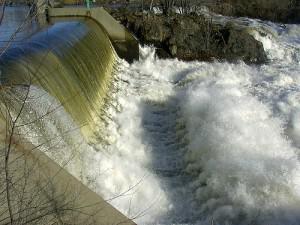
Hydroelectric power is one of the world’s oldest methods of power production. I would venture to guess that Johnny Caveman slapped some stiff leaves or bark on a stick and placed it into a moving river or stream. The power of the water would then rotate the stick, crushing the grain that they used to make prehistoric corn muffins. The power of moving water has been harnessed throughout history, and today we are finding ways to use it to our advantage—from brewing that nighttime tea to opening the garage door in the morning.
United States Hydroelectric Power
The U.S. primarily uses energy created by nuclear power plants or fossil fuels. However, hydroelectricity is growing in the country with eight percent of our power coming from hydroelectric plants. A large power generator is placed inside a dam, and the water which flows through the dam spins the built-in turbine blades of the generator. This creates power that can be used for residential or business purposes.
Worldwide Hydropower
- Hydropower is earth’s most widely used and important renewable energy sources.
- Hydropower represents 20 percent of all electricity production.
- The largest hydroelectricity producer is China, with Canada, Brazil, and the U.S.rounding out the top four.
- Vast hydroelectric resources are still untapped in countries like Latin America, China, India, and Central Africa.
Hydroelectric Power Advantages
- Pollution is eliminated, as no fuel is being burned.
- What could be better than a free, naturally occurring energy source?
- Hydropower helps to reduce greenhouse gas emissions.
- Maintenance and operating costs are low to moderate.
- The technology behind hydropower is proven and reliable.
- There is no other energy source that is as renewable, and as long as we have naturally occurring rain, then the fuel will be there.
Disadvantages to Typical Gas Fuel, Oil, and Coal Power Plants
- Our natural resources are being depleted at an alarming rate because of these plants.
- They create enormous amounts of pollution.
- Digging the wells to harvest these resources disturbs natural plant and animal life.
- Nuclear plants are a disaster when it comes to waste disposal.
The Environmental Impact of Hydropower
As with anything, there is always a slight downside. Hydropower causes zero pollution in the air or water. However, the facilities that are necessary can have significant impacts on the homes, land, natural habitats, and environment in the area of the dam. The structure can hinder the migration of certain fish, thereby affecting their population. Hydroelectric plants can also change the flow and temperature of the river or stream. These changes could impact native animals and plants in and around the river. Building dams can also cause people to be relocated, although that is much rarer.
Join in the discussion in the comments below and/or share the piece.
Photo credit: Some rights reserved by grendelkhan

